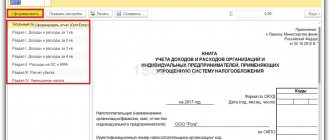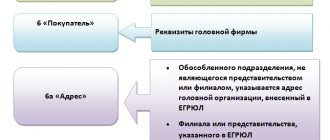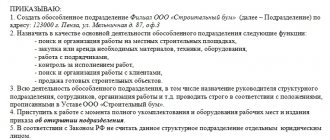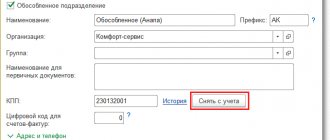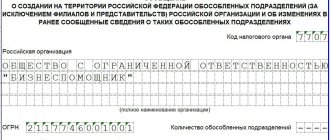Many companies accept cash from customers through structural divisions located outside the place of their state registration. This could be a retail chain or points of provision of services to the public. Often, each such “point” is served by a single employee. Should a separate cash book be maintained in such a department?
Unfortunately, we will not find a simple and clear answer to this purely practical question in the basic regulatory document - the Regulations on the procedure for conducting cash transactions with banknotes and coins of the Bank of Russia on the territory of the Russian Federation, approved by the Bank of Russia on October 12, 2011 No. 373- P (hereinafter referred to as the Regulations), nor in official explanations of the Bank of Russia, the Ministry of Finance of Russia or the Federal Tax Service.
Let's try to figure it out on our own.
Reading the regulatory document
The regulation (paragraph 2, clause 1.2) literally establishes the following: a separate division (branch, representative office) of a legal entity, for the purposes of which the legal entity has opened a bank account, sets a limit on the cash balance. But since there must be a limit, there is also a cash register (paragraph 1, clause 1.2 of the Regulations). Cash transactions are subject to reflection in the cash book (paragraph 9, clause 2.6 of the Regulations). What if a separate unit does not conduct it?
Failure to make entries in the cash book is considered as non-receipt of cash to the cash register (paragraph 2, clause 6.1 of the Regulations). It is regarded as an administrative offense and entails very impressive fines (Clause 1 of Article 15.1 of the Code of Administrative Offenses of the Russian Federation). Control over the completeness of accounting for cash proceeds is carried out by territorial tax inspectorates (clause 5 of the Administrative Regulations for the execution by the Federal Tax Service of the state function of monitoring and supervising the completeness of accounting for cash proceeds in organizations and individual entrepreneurs, approved by order of the Ministry of Finance of Russia dated October 17, 2011 No. 133n). Therefore, it is important for every company that works with cash outside its location to determine the “cash” responsibilities of employees of its departments.
So in what sense is the concept of “separate division” used in the Regulations?
General Audit Department on the issue of maintaining cash documents in a separate division
Answer According to Article 11 of the Tax Code of the Russian Federation, a separate division
An organization is any division territorially isolated from it, at the location of which stationary workplaces are equipped. A separate division is recognized as such regardless of whether its creation is reflected or not reflected in the constituent or other organizational and administrative documents of the organization, and regardless of the powers vested in it. In this case, a workplace is considered stationary if it is created for a period of more than one month.
The procedure for conducting cash transactions is regulated by the Regulations on the procedure for conducting cash transactions with banknotes and coins of the Bank of Russia on the territory of the Russian Federation, approved by the Bank of Russia on October 12, 2011 No. 373-P (hereinafter referred to as Regulation No. 373-P).
Note that Regulation No. 373-P uses the concept of “separate division (branch, representative office)” and clearly defines that separate divisions are branches and representative offices (clause 1.2).
In civil legislation (Article 55 of the Civil Code of the Russian Federation), branches and representative offices are mentioned as separate divisions, information about which is contained in the constituent documents of the organization.
Thus, the norms of the Tax Code of the Russian Federation interpret the concept of a separate division more broadly, i.e. from the point of view of tax legislation, a separate division is any territorially separate division in which stationary workplaces are equipped.
At the same time, the definition of a separate division given in the Tax Code of the Russian Federation is used exclusively to regulate tax relations. While the procedure for registration and accounting of cash transactions does not apply to tax relations.
Meanwhile, I would like to draw your attention to the fact that the Letter of the Federal Tax Service of the Russian Federation dated 06/05/13 No. AS-4-2/10250 concluded that the norms of Resolution No. 373-P in relation to separate divisions apply to all types of separate divisions, regardless of their whether it has the status of a branch or representative office.
A similar conclusion follows from the Resolution of the Thirteenth Arbitration Court of Appeal dated February 25, 2013 No. A56-55039/2012.
Thus, in order to eliminate possible risks of being held accountable for violating the procedure for conducting cash transactions, in our opinion, it is advisable for the Organization to adhere to the opinion expressed by the supervisory authority and proceed from the fact that a separate division
for the purposes of applying Regulation No. 373-P,
any territorially separate division of the Organization in which stationary jobs have been created and which carries out cash transactions is considered
.
Next, we will consider the procedure for processing cash documents in the presence of a separate division.
1. The order of numbering of cash documents in the presence of a registered OP.
Regulation No. 373-P does not establish the numbering order for incoming and outgoing cash orders (PKO and RKO).
Also, no special rules have been established for the numbering of PKOs and RKOs in separate divisions.
In this regard, in our opinion, the Organization has the right to independently establish the order of numbering of PKOs and RKOs in each separate division
.
In practice, if there are separate divisions, the numbering option most often used is in which the PKO (RKO) number consists of two parts, indicated with a hyphen or fraction. The first part of the number identifies a separate division (for example: an alphabetic or numeric code), the second part indicates the serial number of the document in chronological order in this division.
Let us note that it is advisable to consolidate the chosen numbering order in the accounting policy of the Organization for accounting purposes.
2. Preparation of cash books, including whether a consolidated cash book for the day will be needed.
In accordance with clause 5.1 of Regulation No. 373-P, to record cash received at the cash desk, with the exception of cash accepted by the paying agent, bank payment agent (subagent), and issued from the cash register, a legal entity or individual entrepreneur maintains a cash book.
Entries in the cash book are made by the cashier for each PKO (RKO) issued for received (issued) cash (clause 5.2 of Regulation No. 373-P).
According to clause 2.5 of Regulation No. 373-P, the cash book can be prepared on paper or using technical means intended for processing information, including a personal computer and software (hereinafter referred to as technical means).
Cash documents prepared using technical means are printed on paper.
A sheet of the cash book, prepared using technical means, is printed on paper at the end of the working day in two copies.
The numbering of sheets of the cash book, prepared using technical means, is carried out automatically in chronological order from the beginning of the calendar year.
The sheets of the cash book printed on paper are selected in chronological order, bound as necessary, but at least once a calendar year.
The sheets of the cash book, prepared on paper, are bound and numbered before maintenance begins.
Sheets of the cash book of a separate division
are selected and bookleted by a legal entity
for each separate division
.
The certification inscription on the number of sheets of the cash book is signed by the manager and the chief accountant, and in the absence of the chief accountant - only by the manager and is sealed with the seal of a legal entity, the seal of an individual entrepreneur (if any).
In accordance with clause 5.6 of Regulation No. 373-P, a separate division, after displaying in the cash book the amount of cash balance at the end of the working day, transfers the sheet of the cash book for this working day no later than the next working day to the legal entity.
In the case of registering a cash book on paper, a separate division shall transfer a tear-off second copy of the cash book sheet, and in the case of registering a cash book using technical means, a second copy of the cash book sheet printed on paper.
The transfer of a cash book sheet to a legal entity by a separate division can be carried out electronically in accordance with the legislation of the Russian Federation. In this case, the transfer of the cash book sheet on paper is carried out in accordance with the rules of document flow approved by the legal entity.
Based on the foregoing, we can conclude that each separate division of the organization that carries out cash transactions must maintain a cash book.
This conclusion is confirmed by Letter of the Bank of the Russian Federation dated 04.05.12 No. 29-1-1-6/3255, Letters of the Federal Tax Service of the Russian Federation dated 05.06.13 No. AS-4-2/10250, dated 05.17.13 No. AS-4-2/ [email protected] , as well as by the Resolutions of the Thirteenth AAS dated 02.25.13 No. A56-55039/2012, from 04.18.13 No. A56-66829/2012, from 04.04.13 No. A56-56706/2012, the Fourth AAS dated 03.12.13 in case No. A78-8644/2012.
Please note that the absence of a cash book in a separate division, including one that is not a branch or representative office,
is regarded by regulatory authorities as a violation of the procedure for conducting cash transactions, expressed in the non-receipt of cash, due to failure to maintain (failure to register) a cash book and cash documents, which, in accordance with Part 1 of Article 15.1 of the Code of Administrative Offenses of the Russian Federation,
entails the imposition of an administrative fine on officials in the amount of four thousand to five thousand rubles;
for legal entities - from forty thousand to fifty thousand rubles. Thus, based on the above, we can draw the following conclusion about the procedure for registering a cash book in the presence of a separate division:
1. Each separate division maintains its own cash book
and transfers a tear-off second copy of the cash book to the parent organization (no later than the next working day).
2. Headquarters
:
- does not include the cash book indicators of a separate division in its cash book;
— cash book sheets received from a separate division are selected and bookleted (at least once a year) for each separate division separately.
3. Procedure for maintaining the KO-3 journal.
First of all, I would like to draw your attention to the following, Regulation No. 373-P came into force on January 1, 2012. Before this date, the Procedure for conducting cash transactions in the Russian Federation was in force, approved by the Decision of the Board of Directors of the Central Bank of the Russian Federation dated September 22, 1993 No. 40.
Clause 21 of this Procedure provided for the mandatory registration of PKOs and RKOs in the registration log of PKOs and RKOs, the unified form KO-3 of which was approved by Resolution of the State Statistics Committee of the Russian Federation dated August 18, 1998 No. 88.
At the same time, the currently valid Regulation No. 373-P does not establish the obligation to maintain a register of PKOs and RKOs.
In this regard, the Organization cannot be held liable for the absence of the specified journal.
At the same time, in our opinion, the Organization has the right to maintain the specified journal on a voluntary basis in order to control the execution of PKO and RKO (assigning numbering).
At the same time, this journal, in our opinion, should be kept depending on the chosen order of assigning numbering to the PKO and RKO.
So, if the Organization chooses the option we proposed earlier (a fractional number for each division), then it is more expedient to keep the specified journal separately for each separate division. If the Organization chooses the option of continuous numbering of PKO and RKO for the Organization as a whole, then the specified journal must be kept in one copy in the parent organization.
With regard to the possibility of maintaining accounting records of cash transactions on account 50.1 “Cash” in the context of sub-accounts for each separate division, we note the following.
In accordance with the Instructions for the use of the Chart of Accounts, account 50 “Cash desk of the organization” is intended to summarize information about the availability and flow of funds in the cash registers of the organization.
Sub-accounts can be opened for account 50 “Cashier”:
50.1 “Organization cash desk”,
50.2 “Operating cash desk”,
50.3 “Cash documents”, etc.
Subaccount 50.1 “Cash of the organization” records the funds in the cash desk of the organization. When an organization carries out cash transactions with foreign currency, then corresponding sub-accounts must be opened to account 50 “Cash” for separate accounting of the movement of each cash foreign currency.
Subaccount 50.2 “Operating cash desk” takes into account the availability and movement of funds in the cash desks of commodity offices (piers) and operational areas, stopping points, river crossings, ships, ticket and baggage offices of ports (piers), train stations, ticket storage offices, post office office offices and so on. It is opened by organizations (in particular, transport and communications organizations) if necessary.
Subaccount 50.3 “Cash documents” takes into account postage stamps, state duty stamps, bill stamps, paid air tickets and other monetary documents in the organization’s cash desk. Cash documents are accounted for on account 50 “Cash” in the amount of actual acquisition costs. Analytical accounting of monetary documents is carried out by their types.
From the specified analytics established by the Instructions for the use of the Chart of Accounts, we can conclude that analytical accounting of funds is carried out not only by types of funds (for example, cash and monetary documents), but also by places of their storage (organizational cash desk and cash registers). outside the organization's office).
At the same time, the preamble of the Instructions for the use of the Chart of Accounts establishes that the subaccounts provided for in the Chart of Accounts are used by the organization based on the requirements of the management of the organization, including the needs of analysis, control and reporting. The organization can clarify
the content of the subaccounts shown in the Chart of Accounts, exclude and combine them, as well as introduce additional subaccounts.
In this regard, in our opinion, if the Organization has separate divisions that are not allocated to a separate balance sheet, and the Organization needs to organize analytical accounting of funds in the cash register separately for each separate division, in our opinion, it has the right open corresponding sub-accounts for account 50.1 or keep records in the context of the corresponding “sub-account”
.
Answers to the most interesting questions on our telegram channel knk_audit
Back to section
Linguistic analysis
First, let’s look at the construction of “a separate division (branch, representative office) of a legal entity (hereinafter referred to as a separate division)” used in the Regulations. When listing, brackets are used not for the purpose of clarifying (specifying, narrowing) the first of the listed terms, but to designate alternative or additional options to it. This is evidenced by numerous examples from the text:
- bank payment agent (subagent);
- seal (stamp);
- cash book (book of accounting of funds accepted and given by the cashier);
- payroll (payroll);
- expense cash order (settlement and payroll sheet, payroll);
- name (company name);
- incoming cash order (outgoing cash order);
- cash received (issued).
This means that “branch” and “representative office” are not decodings or explanations for “separate division”, especially since any object from the list of interest to us - “separate division”, “branch” and “representative office” - for the purpose of applying the Regulations is generally referred to as a separate division (using the clause “further”). It would seem that a separate division in the “cash” sense is not reducible to the generally established meaning of the term “separate division.”
For information
A separate division of a legal entity is necessarily characterized by its location outside its location.
Formal linguistic analysis forces us to admit that a separate division, branch and representative office are equivalent concepts from the point of view of the Regulation. Therefore, it is impossible to agree with the opinion that only branches and representative offices are considered separate divisions in the Regulations.
Cash book of a separate division in 1C 8.3
The question often arises of how to maintain a cash book by division in 1C 8.3, if the enterprise actually has two cash registers: a central one and a separate division.
In 1C Accounting 8.3 for not very large enterprises it is not possible to maintain two cash registers. Thus, in the database of an organization with a separate division, only the “head” cash book will be formed. The ability to maintain several cash registers in one database for the main activity is provided only by 1C Accounting 8.3 CORP.
And in the basic version and version PROF 1C Accounting 8.3, account 50.02 available in the plan is intended for accumulating and transferring funds through the cash desk of a separate division, but not a single transaction involving account 50.02 will be included in the cash book. Moreover, if it is necessary for documents for the central cash register to be numbered consecutively continuously, you will have to manually adjust the numbers of cash documents with the account 50.02.
How to restore the chronological numbering of cash documents in 1C 8.3 using Express check, read our article.
This is what it looks like. Let's consider in the basic version and the PROF 1C Accounting 8.3 version the receipt of revenue from a separate division and its delivery to the head division, and then to the bank in one day:
- PKO 9: Dt 50.02 Kt 90.01.1 – 26,000 rub. (revenue from a separate division was received);
- RKO 11: Dt 57.01 Kt 50.02 – 26,000 rub. (the OP’s revenue was transferred to the central cash desk);
- PKO 10: Dt 01 Kt 57.01 – 26,000 rub. (the OP’s revenue is credited to the central cash desk);
- RKO 12: Dt 51 Kt 01 – 26,000 rub. (OP's revenue from the central cash desk is deposited in the bank):
Note! Four documents: PKO 9, PKO 10, RKO 11 and RKO 12, but only two were reflected in the cash book: PKO 10 and RKO 12:
The cash register of a separate division will have to be maintained in a separate database or manually.
List of objects
The next step is to understand the meaning of each of the independent objects - “separate division”, “branch”, “representative office”.
At first glance, we are talking about territorial isolation, which is characterized by an address different from the state registration address of the company.
Accountants tend to view a separate division in the special meaning given to this term by tax law. The main feature of such a separate unit is the period for which workplaces are equipped in it. And if a workplace exists for less than a month, then it does not generate a separate division. However, we should not forget about the limited application of this criterion. Such a sign of a separate division as a term “works” only in acts of legislation on taxes and fees. This is directly stated in paragraph 1 of paragraph 2 of Article 11 of the Tax Code. The regulation adopted by the Bank of Russia does not apply to such acts (Clause 1, Article 4 of the Tax Code of the Russian Federation). It is intended to organize cash circulation (Article 34 of the Law of July 10, 2002 No. 86-FZ “On the Central Bank of the Russian Federation (Bank of Russia)”).
Let us explain this with a specific example. Let's assume that a company has opened a retail outlet without defining a period and it has been operating for less than a month. From the point of view of tax legislation, it does not have a separate division. But this does not mean that there is none for the purpose of maintaining cash discipline. This position is supported by the letter of the Ministry of Finance of Russia dated October 8, 2012 No. 03-02-07/1-242. It emphasizes that an organization that has a separate “tax” division is subject to registration with the tax authority at the location of such division. But the fact of such accounting cannot influence the procedure for conducting cash transactions.
Notification deadlines for the Federal Tax Service
According to paragraph 3 of paragraph 2 of Article 23 of the Tax Code of the Russian Federation, organizations are required to report to the tax authority, respectively, at the location of the organization:
- About all separate divisions of a Russian organization created on the territory of the Russian Federation (with the exception of branches and representative offices), and changes to information about such separate divisions previously reported to the tax authority:
- within one month from the date of creation of a separate division of the Russian organization;
- within three days from the date of change in the relevant information about a separate division of the Russian organization.
The termination of the organization’s activities through a separate division of the Federal Tax Service must be notified within three days from the date of such termination (clause 3.1, clause 2, article 23 of the Tax Code of the Russian Federation).
Definitions of terms
We will find the characteristics of the terms that interest us in Article 55 of the Civil Code. And an amazing surprise awaits us in it. It does not follow from the wording of the article that a separate division of a legal entity is necessarily characterized by its location outside its location, which is determined by the place of its state registration (clause 2 of Article 54 of the Civil Code of the Russian Federation). This territorial isolation is specially stipulated in tax legal relations, that is, it is of fundamental importance.
It is not difficult to imagine separate divisions located at the “legal” address of the company. For example, in one task owned by her, several stores of different profiles (for example, selling food and sporting goods), a restaurant, etc. can be located. A separate room is allocated for each type of activity, but this fact is not reflected in the Unified State Register of Legal Entities.
Branch and representative office are special types of separate divisions. They must, firstly, be located outside the location of the legal entity, and secondly, they must certainly be indicated in its constituent documents.
As a result, we identified the source of difficulties in understanding the requirements of the Regulations. And they came to the conclusion: the territorial address feature is not a mandatory criterion for isolation.
According to the author, branches and representative offices are highlighted in the Regulations in order to emphasize the civil legal status of separate units. But it wasn’t even necessary to do this. After all, branches and representative offices are also separate divisions. But the opinion of some experts that the Regulations define separate divisions as branches and representative offices is a misconception.
Attention
If a department conducts cash transactions, it is required to maintain a cash book. Moreover, it is not at all necessary to use a bank account.
Is it possible to avoid registering at the address of a separate subdivision?
Some entrepreneurs trade using one device in several places or simply do not want to re-register it later and are looking for ways to bypass specifying the address during registration. Let's look at some of these “methods”.
Registration of cash registers for outbound trade
There is an opinion that this is possible if you enter the phrase “outbound trade” in the address line of the application. However, this is not true. The popularity of this opinion is due to the incorrect interpretation of the letter of the Department of Tax Administration in Moscow “On the use of cash register machines...” dated 04/17/2002 No. 29-12/17513, which explains the procedure for using cash register machines exclusively for outbound sales (that is, the letter is simply not applicable for other types of sales).
There is a rather narrow definition of the very concept of outbound trade, which can be found in GOST R 51303-2013, approved by order of Rosstandart dated August 28, 2013 No. 582-st. According to this document, distribution trade is understood as small-scale retail trade outside a stationary retail chain, subject to the use of equipped transport and special mobile equipment to be used exclusively in the vehicle.
This significantly narrows the range of possibilities in which such registration will be justified and legal. In particular, if an entrepreneur uses such a device in the office, there is a violation of the law. After all, the method is acceptable only if trade is carried out directly using vehicles.
However, it must be recognized that the law does not really limit the number of checks that can be issued in one place, and such a solution may well be suitable for those who trade on an ongoing basis using transport (even if he does not move during sales). At the same time, the cash register itself must be able to operate on battery power, that is, be mobile.
Registering a cash register as a backup
The second option is to register the cash register as a backup. Indeed, in accordance with the explanations given in the letter of the Federal Tax Service for Moscow dated February 11, 2005 No. 22-12/9705, it is possible to register a spare cash register marked “reserve” in the address line. However, it is not indicated that it is necessary to register the main cash register before registering the reserve one.
However, there is one caveat: in accordance with clause 21 of the Administrative Regulations, approved by Order of the Ministry of Finance dated June 29, 2012 No. 94n, KKM is subject to use in the service territory of the tax division that registered it. This means that if the cash register is used outside this territory, the organization risks being punished in the form of a fine under Part 4 of Art. 14.5 Code of Administrative Offenses of the Russian Federation. Thus, this should not be considered a way to avoid registration at the unit address.
The role of the bank account
The Regulations say that the limit is set by separate divisions for the purposes of which a legal entity has opened a bank account. This formulation was another source of controversy. It would seem that if an account was not specifically opened to service the unit, then there is no reason to set a limit. And, accordingly, keep a cash book.
But the Bank of Russia objects to such an interpretation. In letter dated May 4, 2012 No. 29-1-1-6/3255, he explains that the requirement to maintain a cash book must be observed by each separate division conducting cash transactions, regardless of the presence of a bank account of a legal entity opened for carrying out separate transactions division. This position was adopted by the tax authorities (clause 1 of the letter of the Federal Tax Service of Russia dated September 12, 2012 No. AS-4-2/15195).
It is difficult to argue with this point of view, since the owner of the account is not a separate division, but a legal entity. The possibility of using the account by employees of the unit is established by the company and is not limited externally, by the bank.
If a department conducts cash transactions, it is required to maintain a cash book. Moreover, the division does not have to use a bank account to comply with the limit. Over-limit cash can also be deposited at the head office (paragraph 2, clause 1.5 of the Regulations).
Filling out the cash book manually (sample algorithm for working with a document)
The procedure for manually maintaining a cash book requires stitching and numbering it before entering data. The main feature of the paper version of the cash book is that the document is divided into 2 parts - the main and detachable ones.
When starting a shift, the cashier must place the tear-off part of the cash book under the main one, and place carbon paper between them. Then you need to record the cash balance as of the beginning of the day. During the shift, data on PKO and RKO should be recorded in the cash book - according to the columns that we discussed above.
At the end of the shift, the cashier must count all the turnover for PKO and RKO for the day and record them in the cash book, put his signature on the document, and then take it along with the orders to the accountant.
Read about sanctions for violating the rules for conducting cash transactions in the article “Cash discipline and responsibility for its violation.”
Conducting cash transactions: comparison of current and old rules
For clarity, we will present the main changes in the procedure for conducting cash transactions in the form of a table (comparison of current and previous rules, including taking into account those introduced by Directive No. 5587-U, effective from November 2022, and No. 4416-U of 2022).
| Operations affected by changes | Changes in the procedure for conducting cash transactions from November 30, 2020 | The procedure for conducting cash transactions, in force since 2017 |
| Issuance of money on account | The calculation rules have not changed except for the following aspects:
| To issue cash to an employee on account for expenses associated with the activities of a legal entity or individual entrepreneur, an expense cash order is drawn up in accordance with a written application of the accountable person, drawn up in any form, or an administrative document of the manager. The application or administrative document must contain a record of the amount of cash and the period for which it is issued, as well as the manager’s signature and date. If an application is drawn up for accountable amounts, then the manager is not required to indicate the amount of accountable funds and the period. The accountable himself can do this. And the manager will only sign and date it. Issuance on account is allowed if the recipient has not reported on the previous advance. |
| Interaction between the head office and department offices | Separate divisions have the right not to keep a cash book if they do not store funds, but hand them over to the cash desk of the parent organization. | An organization that has separate divisions (SU) has the right to independently establish the procedure and timing for transferring to the parent organization copies of the SE's cash book sheets, taking into account the deadline for drawing up accounting (financial) statements (clause 4.6 of Directive No. 3210-U). |
| Requirements for working with automatic devices for accepting and issuing money without the participation of employees (vending machines) have been approved. | The name of software and hardware has been changed to automatic devices for receiving and squeezing money without the participation of workers. They must automatically accept and issue banknotes and be able to recognize at least 4 machine-readable security features over the entire area of the banknote given in paragraph. 14–19 clause 1.1 of the Central Bank Regulations dated January 29, 2018 No. 630-P. | Software and hardware must be “able” to recognize banknotes based on 4 security features established by the regulations of the Central Bank. |
| New rules for accepting and issuing banknotes | When accepting banknotes, the cashier is required to check their solvency. At the same time, he is obliged to accept banknotes that do not contain signs of counterfeiting, are without damage or have abrasions, extraneous inscriptions, punctures, missing corners or edges and other minor damage. The cashier is prohibited from issuing banknotes that have one or more damages such as extraneous inscriptions of 2 or more characters, violation of the integrity of the banknote, a lost corner (more than 32 sq. mm) or a torn edge (7 mm or more in length), as well as other damage , specified in paragraph. 6–15 clause 2.9 of the Central Bank Regulations No. 630-P. Such banknotes should be handed over to the bank. | — |
| Identification of the recipient of funds | The cashier must ensure that cash is issued to the person indicated in the cash receipt order. Request for document verification. identification is excluded. | When issuing funds, the cashier is required to check the identity document. |
| Salary deposit | The rule about reflecting in the payroll the deposit of wages not paid on time is excluded. | On the last day of issuing cash intended for payment of wages, the cashier in the payroll record makes an entry “deposited” opposite the names and initials of employees who have not been issued cash, calculates and writes in the final line the amount of cash actually issued and the amount subject to deposit. |
You can learn about other innovations from ConsultantPlus materials by receiving free demo access to the K+ system.
ConsultantPlus experts described a step-by-step algorithm for conducting cash transactions and maintaining cash discipline. Get free demo access to K+ and go to the Ready Solution to find out all the details of this procedure.
In addition to Instructions No. 3210-U, businessmen must comply with Instructions No. 5348-U dated 12/09/2019. According to this document, firms and individual entrepreneurs have the right to spend cash received for goods (work, services) sold exclusively for payment:
- employee salaries;
- insurance compensations under insurance contracts;
- remuneration for work/services, as well as for payment for goods (within 100 thousand rubles under one contract);
- accountable funds;
- for personal needs of individual entrepreneurs not related to entrepreneurship;
- returns for goods (work/services);
- issuing loans, etc.
Individual entrepreneurs can use a simplified method of conducting cash transactions. If you have access to ConsultantPlus, check whether you are accounting for the entrepreneur’s funds correctly. If you do not have access, get free trial access to the system and proceed to the Ready-made solution.
Let’s combine the requirements of the Central Bank Directives into a convenient scheme:
How should PKO and RKO be numbered?
Many organizations begin to number PKO and RKO again from the beginning of the year. However, not a single legislative or explanatory document of the regulatory authorities contains such a rule. It is dictated only by the convenience of recording data from primary cash documents. Strictly speaking, it is not necessary to start in January with one; you can continue the continuous numbering of cash orders from last year.
Large organizations with a large cash flow of documents often establish in their accounting policies the quarterly numbering of PKO and RKO, i.e. Every quarter they begin to number documents anew.
With any numbering method chosen, two rules must be observed:
- numbering must be continuous;
- numbering must be chronological.
This means that incoming and outgoing orders must be numbered in the order in which they were issued, taking into account the calendar dates of cash transactions.
On a note! The number, unlike the date, in itself is not a mandatory requisite of the accounting document (see Federal Law No. 402 “On Accounting” dated 6-12-11, Article 9 Part 2).
Article 15 of the Code of Administrative Offenses of the Russian Federation is devoted to violations of the procedure for conducting cash transactions. It does not directly stipulate responsibility for violating the numbering of cash receipts and expenditure orders, but only for violating the procedure for working with cash at the cash desk. At the same time, if the numbering order is not observed, for regulatory authorities this may become a signal indicating serious violations of the law.
Results
There are no plans to make any changes to the procedure for conducting cash transactions in 2022. The rules as amended in 2022, effective from 11/30/2020, continue to apply. Some of the innovations affected the procedure for working with accountants. Other changes were related to the separation and handling of damaged banknotes.
You can find more complete information on the topic in ConsultantPlus. Free trial access to the system for 2 days.

